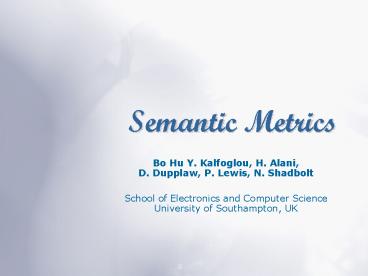Semantic Metrics - PowerPoint PPT Presentation
1 / 21
Title:
Semantic Metrics
Description:
Ontology authoring and publishing is far easier than we once could imagine ... the aggregated distance between an ontology and a group of concepts. Future ... – PowerPoint PPT presentation
Number of Views:103
Avg rating:3.0/5.0
Title: Semantic Metrics
1
Semantic Metrics
- Bo Hu Y. Kalfoglou, H. Alani,
- D. Dupplaw, P. Lewis, N. Shadbolt
- School of Electronics and Computer Science
- University of Southampton, UK
2
Gist
- Yet another metrics?
- Current approaches
- Why we need yet another one?
- Background
- Distance measures
- Description logics
- Distances between concepts
- signaturing concepts
- How far apart are they?
- Beyond concept distances
- Discussion and Conclusions
3
Why we need it?
- Ontology authoring and publishing is far easier
than we once could imagine - Gxxgle person ontology 574 returns
- Swxxgle person 3967 results
- person is defined in FoaF, Akt-portal,
umbc-publication, etc. in different ways. - Semantic distance is the root for many semantic
web tasks - Ontology mapping/alignment/articulation/merging
- Ontology search, ranking and reuse
- Ontology segmentation
- Ontology evaluation
4
Current approaches
- Name-based and lexical approaches
- Consider only names and URIs with help from
lexicons, e.g. WordNet, UMLS - Ignore concept definitions
- Graph-based approaches
- Convert ontologies into graphs
- Ignore the difference among links
- Feature-based approaches
- Discompose concepts as features
- Process of featuring concepts is not formally
studied - Should interim concepts along inheritance paths
or role chains be considered equally important? - Logic-based approaches
- Rewrite as SAT problem
- Only gives abstract relations
5
Background
6
Distance functions
- A distance function satisfies non-negative,
symmetry and triangle inequality - Some distance measures
- Minkowski distance
- Vector space model
- Kullback-Leibler divergence
7
Description logics
- Subset of FOPL describing knowledge with concepts
and roles - father is a man whose child is a human
- Morden DL systems are built on Tableau-based
algorithms - Underlying logic for OWL-Lite, OWL-DL
- OWL-DL is based on SHOIN
- SHOIN constructs
8
Semantic distance measure
- Take full advantage of DLs
- Unfold concepts into signatures
- Weight semantics-bearing signatures
- Compute distance
9
Signaturing concepts1/3
- In DLs, concepts are restricted with roles
through role value (range) and role cardinality
restrictions - E.g.
- Unfold all the relevant restrictions
- Beth definability implicit restriction can be
made explicit - Acyclic definitions
10
Signaturing concepts2/3
- Unfolding rules
- Tableau construction rules of DL (Baader, et.al.
2003) - Disjoint is explicated as complement
11
Signaturing concepts3/3
- Examples
- Signature of book, elements are tuples headtail,
A-Box assertions - Signature of author
- Implicit restrictions on authors have been
expanded as part of the Book signature
12
Weighting signatures
- tf-idf
- Why tf-idf vector space model?
- Provide a foundation for computing numeric
similarity - Computationally cheap and easy to implement
- Emphasise on differences
- Pure syntactic approach
- Add semantic flavour
- Assign -1 to complement
- Reduce the weight value based on its contexts
- Weight of hasPublication property referred to
in author concept is
13
Computing distances
- Distance between concepts is reduced to distance
between signature vectors - Compute similarity of signature
- vectors
- Compute distance of signatures
- Find the minimum distance of concepts
14
The distances
- Symmetric, non-negative
- Only a relative value
- Bigger distance value suggests two concepts are
further apart - 0 suggests identical concepts
- Disadvantages
- Only a distance value, not able to represent
abstract relations, e.g. more general than, more
specific than - A mix of semantic and syntactic methods,
difficult to formalise - Cannot handle negative similarity values.
- Advantages
- Anonymous concepts, e.g. ltowlRestrictiongt, are
made explicit. - Non-primitive concepts are recursively unfolded
- Interim concepts are replaced with their
signatures. - Weights are computed systematically.
15
Extending semantic metric of concepts
16
Distance between concept from different ontologies
- Effectively, ontology mapping
- Inputs from other systems and human experts are
necessary - ?(C, C) need to be initiated with mappings among
primitive concepts and properties from different
ontology - Initial mappings can be defined based on concept
names - String distance based algorithms
- WordNet, UMLS, etc.
- Compute distance
- Compute similarity of signatures
- vectors
17
Distance between concept and a set of concepts
- Distance between C and group of concepts O
- Accumulate individual similarities
- ?(O,C) is accumulated as the information gain of
each concept in O with regard to C. - Emulate probability with similarity
- Yet, probability ? similarity
- p(DC) sim(D,C) / ?D?O sim(D, C)
18
Distance between groups of concepts
- Compute as an aggregation of pair-wise concept
distances - Aggregation method
- Mindowski ?1,2,
- Kullback-Leibler
- A perfect concept C0 is defined as the
reference point - p(Ck) computed as the relative tightness with
regard to C0
19
Discussion and conclusions
- Possible applications
- Ontology mapping
- Ontology segmentation
- Compute distance between concepts
- Cut off concept below the threshold
- Ontology ranking
- Compute the aggregated distance between two
ontologies - Or compute the aggregated distance between an
ontology and a group of concepts. - Future work
- Neat solution for un-unfolded universal
quantification - Find a proper p(DC) replacement
- Problem with tf-idf
- How to treat negative concept similarity
- Syntactic based, a semantic-oriented weight
schema - More evaluation is forthcoming
20
Questions?
21
(No Transcript)































